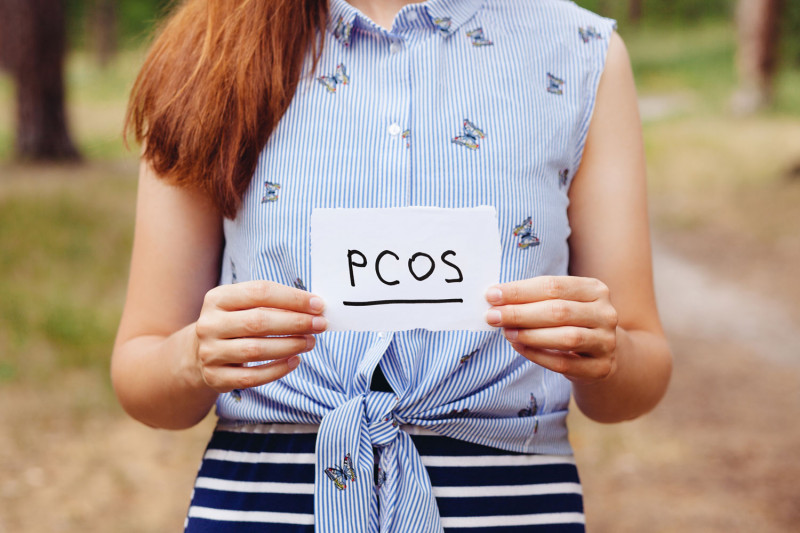
Polycystic ovary syndrome (PCOS) is a condition that is diagnostically characterized with irregular menstruation secondary to abnormal ovarian functions and presence of multiple small bead-like cysts (that’s why the condition is called as polycystic) on the wall of the ovary. This syndrome can be accompanied by certain conditions such as obesity, abnormal hair growth (hirsutism), acne and oily skin. The prevalence is approximately 10 percent.
Individuals with polycystic ovary or their family members may have tendency to x, high insulin level, elevated blood glucose or type II diabetes that can be pointed out by abnormal glucose loading test results. Therefore, a regular follow-up is recommended.
Ovulatory function of individuals with polycystic syndrome is either low or paused. As a consequence, they will have a tendency to infrequent menstruation. Ultimately, such persons can face difficulty in getting pregnant. As the case for all other disease, a single definition does not fit to all patients with polycystic ovaries. While some individuals with polycystic ovary syndrome achieve unassisted conception, others may require treatment and in vitro fertilization therapies.
The treatment of polycystic ovary syndrome is personalized according to the needs of each patient. Regulation of menstrual cycles may be sufficient for a patient with menstrual irregularity alone, while insulin sensitizing treatment is planned and diet, exercise and endocrinology consultations, if required, are considered for patients with obesity and insulin resistance. The patients who present with request of conception are usually started on ovulation therapies. It is also important to assess the spouse.
Pills (such as clomiphene citrate) or injections (gonadotropin stimulations) are available for ovulatory treatment of a patients with polycystic ovary syndrome. There are a couple of remarkable issues in this group of patients.
1 – Ovarian hyperstimulation syndrome (OHSS)
Individuals with polycystic ovary syndrome can response to the ovarian stimulation by developing abnormally high number of follicles. This condition may lead to a syndrome that has various forms, ranging from mild to severe, characterized with enlargement of ovary into a cystic formation, abnormal hormone elevation, collection of fluid in intra-abdominal cavity (ascites) and increased tendency to intravascular blood clotting. OHSS can require prolonged follow-ups, hospitalizations or prolonged treatments, even longer and harder if the patient gets pregnant as a result of the treatment. Although it is not possible to eliminate this condition completely, the risk can be minimized by choosing stimulation protocols and doses carefully. Especially for IVF patients who meet particular criteria, ovulation is induced by GNRH agonist in GNRH antagonist protocols and thus, the risk of OHSS is minimized as HCG injection can be avoided.
2 – Multiple pregnancies
This condition is less frequently encountered since the number of embryo transfers in in vitro fertilizations is reduced and blastocyst transfer is commonly used. However, it is a more remarkable issue for patients with polycystic ovary, who receive ovulation treatment apart from in vitro fertilization. While relevant treatment protocols prescribed the cancelation of treatment for patients who develop more than one follicle, individuals with polycystic ovary syndrome develop a signle follicle rarely. Due to these concerns, in vitro fertilization is more commonly preferred for patients with reproductive problem and it may a generate a solution that minimizes risks of OHSS and multiple pregnancy.
Although patients with polycystic ovary syndrome often produce abundant oocytes during IVF treatment, they commonly face egg quality problems. This problem is generally related to the androgen level in the ovary and many methods, including but not limited to low-dose stimulation protocols, use of oral contraceptive and avoiding gonadtropins that contain LH, are used to overcome the problem. Pausing ovarian stimulation for one or a couple of days, waiting for the level of estradiol to reduce below critical levels (coasting) and stimulating ovulation with GnRH agonist are precautions we refer frequently. Freezing all embryos and delaying the pregnancy for patients with a high risk of hyperstimulation have significant benefits and it can also, contrary to the popular belief, increase the success rate in hyperstimulated patients.
The In Vitro Fertilization implies fertilizing a human oocyte with a human sperm at the laboratory settings and transferring the resultant embryo into the womb.
The robotic rehabilitation is a treatment modality used to restore the walking ability in patients with total or partial loss of the gait function. The robotic rehabilitation is an evidence-based treatment that also involves virtual reality processes.
All pre-and post-operative procedures of the kidney transplant are extremely crucial for the health of both the recipient and the donor.
The check-up examinations allows treatment of the diseases successfully before the condition progresses to the symptomatic stage, as it ensures early diagnosis of many diseases.
An aesthetic look is important for most women. Certain processes that can cause deformities in women's body can make them feel unhappy and desperate.
Breast cancer is the most common type of cancer in women not only in our country but also worldwide.
As coronavirus (COVID-19) pandemic progresses, scientists teach us more about the virus and how it progresses.